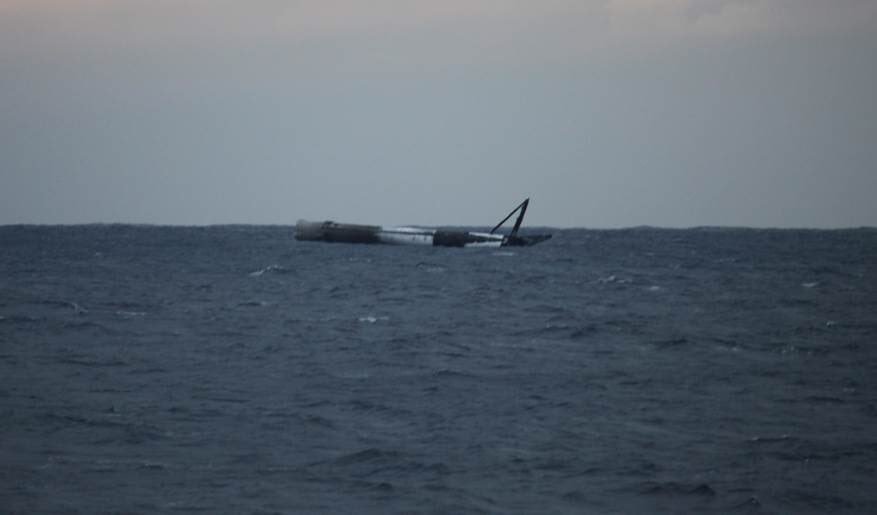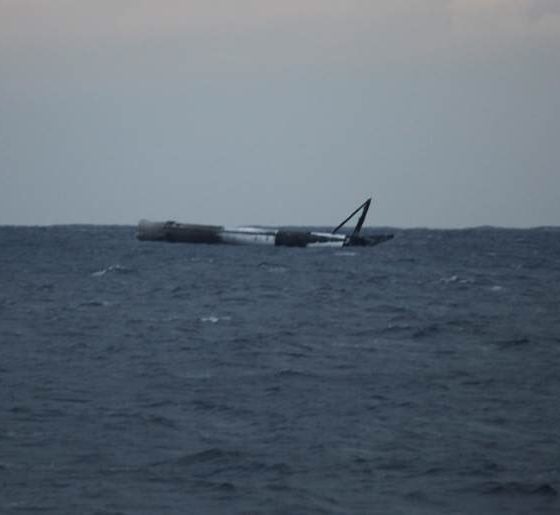

News
Elon Musk reveals SpaceX Falcon 9 survived a water landing test
Following the picture-perfect launch of GovSat-1 on Wednesday afternoon, SpaceX CEO Elon Musk took to Twitter with an extremely unusual bit of news. After separating from the second stage, events relating to Falcon 9’s first stage recovery operations were heard live in the background of SpaceX’s live coverage, leading to some additional intrigue around an already odd situation.
B1032, a flight-proven (reused) booster tasked with launching GovSat-1 on its second mission, was seen with landing legs and grid fins on its sooty exterior – a confusing appearance due to SpaceX’s statement that the core would be expended into the ocean after launch. Thankfully, Elon Musk’s tweets provide at least the beginning of an answer for the several oddities.
This rocket was meant to test very high retrothrust landing in water so it didn’t hurt the droneship, but amazingly it has survived. We will try to tow it back to shore. pic.twitter.com/hipmgdnq16
— Elon Musk (@elonmusk) January 31, 2018
As stated above, GovSat-1’s Falcon 9 booster (1032) was apparently being used to test an exceptionally aggressive landing burn in lieu of a drone ship beneath it. The lack of drone ship begins to make more sense with the added knowledge that 1032 was testing experimental landing procedures: in the relatively likely eventuality that something went wrong, the massive booster would have likely impacted Of Course I Still Love You at an extremely high velocity. Similar impacts have occurred before as SpaceX gradually perfected the new technologies and operational knowledge necessary to recover orbital-class rockets, but a basic understanding of rocketry implies that 1032’s OCISLY impact would have been uniquely destructive, likely taking the ship out of action for at least several weeks of repairs.
This would pose an inherent problem for the imminent launch of Falcon Heavy, with the center of three first stages currently scheduled to attempt a landing aboard the very same drone ship in less than a week. Under optimum conditions (sans huge explosions and general destruction), OCISLY and its entourage of support vessels simply could not complete the journey back to Port Canaveral and the subsequent return to sea that would have been necessary to recovery both GovSat-1 and Falcon Heavy’s center core. Add in the potential need for repairs and expending GovSat-1 was a no-brainer for the launch company: Falcon Heavy’s center core could easily see at least one additional launch after it is recovered, whereas the twice-used 1032 effectively reached the end of its useful life after it separated from the second stage and GovSat payload earlier today.
As a result, SpaceX appears to have continued a trend of exploiting flight test opportunities to the greatest extent practicable by tasking B1032 with an experimental landing attempt. More specifically, Elon quickly added that the landing burn attempted by 1032 involved the ignition of three of the booster’s nine Merlin 1D engines during landing, whereas all SpaceX landings up to this point have occurred with a single Merlin 1D ignition. While the company already routinely utilizes three engines during some boostback and reentry burns, landing burns have always featured a single engine. However, by using three engines, it is entirely possible that SpaceX hopes to eventually move towards even more aggressive landing burns. While the obvious downsides likely include difficulty maintaining control and increased stresses on the booster, the benefits are also pretty inherent. By using more engines, the length of the landing burn could be drastically shortened, resulting in far more efficient propellant usage by minimizing losses to gravity (every second the rocket is trying to go upwards is a second fighting against Earth’s gravity, which pulls the rocket down at ~9.8 meters/second squared).
Incredibly, the booster somehow managed to pull off that three engine landing burn with some success, made apparent by the fact that it is intact and floating in the Atlantic, with some hope of being towed back to land. This is almost certainly the first time SpaceX has ever successfully landed a booster in the ocean without a subsequent breakup, an incredible achievement for a rocket that likely experienced exceptional stresses during reentry and landing. Time will tell how this impacts SpaceX’s future recovery efforts, but it is certainly promising as a method of extracting just a little extra performance from reusable Falcon 9s. In other words, future Falcon 9 missions might be able to carry heavier payloads into higher orbits while still being able to land at sea or even on land. Exciting times!

News
Tesla is not sparing any expense in ensuring the Cybercab is safe
Images shared by the longtime watcher showed 16 Cybercab prototypes parked near Giga Texas’ dedicated crash test facility.

The Tesla Cybercab could very well be the safest taxi on the road when it is released and deployed for public use. This was, at least, hinted at by the intensive safety tests that Tesla seems to be putting the autonomous two-seater through at its Giga Texas crash test facility.
Intensive crash tests
As per recent images from longtime Giga Texas watcher and drone operator Joe Tegtmeyer, Tesla seems to be very busy crash testing Cybercab units. Images shared by the longtime watcher showed 16 Cybercab prototypes parked near Giga Texas’ dedicated crash test facility just before the holidays.
Tegtmeyer’s aerial photos showed the prototypes clustered outside the factory’s testing building. Some uncovered Cybercabs showed notable damage and one even had its airbags engaged. With Cybercab production expected to start in about 130 days, it appears that Tesla is very busy ensuring that its autonomous two-seater ends up becoming the safest taxi on public roads.
Prioritizing safety
With no human driver controls, the Cybercab demands exceptional active and passive safety systems to protect occupants in any scenario. Considering Tesla’s reputation, it is then understandable that the company seems to be sparing no expense in ensuring that the Cybercab is as safe as possible.
Tesla’s focus on safety was recently highlighted when the Cybertruck achieved a Top Safety Pick+ rating from the Insurance Institute for Highway Safety (IIHS). This was a notable victory for the Cybertruck as critics have long claimed that the vehicle will be one of, if not the, most unsafe truck on the road due to its appearance. The vehicle’s Top Safety Pick+ rating, if any, simply proved that Tesla never neglects to make its cars as safe as possible, and that definitely includes the Cybercab.
Elon Musk
Tesla’s Elon Musk gives timeframe for FSD’s release in UAE
Provided that Musk’s timeframe proves accurate, FSD would be able to start saturating the Middle East, starting with the UAE, next year.

Tesla CEO Elon Musk stated on Monday that Full Self-Driving (Supervised) could launch in the United Arab Emirates (UAE) as soon as January 2026.
Provided that Musk’s timeframe proves accurate, FSD would be able to start saturating the Middle East, starting with the UAE, next year.
Musk’s estimate
In a post on X, UAE-based political analyst Ahmed Sharif Al Amiri asked Musk when FSD would arrive in the country, quoting an earlier post where the CEO encouraged users to try out FSD for themselves. Musk responded directly to the analyst’s inquiry.
“Hopefully, next month,” Musk wrote. The exchange attracted a lot of attention, with numerous X users sharing their excitement at the idea of FSD being brought to a new country. FSD (Supervised), after all, would likely allow hands-off highway driving, urban navigation, and parking under driver oversight in traffic-heavy cities such as Dubai and Abu Dhabi.
Musk’s comments about FSD’s arrival in the UAE were posted following his visit to the Middle Eastern country. Over the weekend, images were shared online of Musk meeting with UAE Defense Minister, Deputy Prime Minister, and Dubai Crown Prince HH Sheikh Hamdan bin Mohammed. Musk also posted a supportive message about the country, posting “UAE rocks!” on X.
FSD recognition
FSD has been getting quite a lot of support from foreign media outlets. FSD (Supervised) earned high marks from Germany’s largest car magazine, Auto Bild, during a test in Berlin’s challenging urban environment. The demonstration highlighted the system’s ability to handle dense traffic, construction sites, pedestrian crossings, and narrow streets with smooth, confident decision-making.
Journalist Robin Hornig was particularly struck by FSD’s superior perception and tireless attention, stating: “Tesla FSD Supervised sees more than I do. It doesn’t get distracted and never gets tired. I like to think I’m a good driver, but I can’t match this system’s all-around vision. It’s at its best when both work together: my experience and the Tesla’s constant attention.” Only one intervention was needed when the system misread a route, showcasing its maturity while relying on vision-only sensors and over-the-air learning.
News
Tesla quietly flexes FSD’s reliability amid Waymo blackout in San Francisco
“Tesla Robotaxis were unaffected by the SF power outage,” Musk wrote in his post.

Tesla highlighted its Full Self-Driving (Supervised) system’s robustness this week by sharing dashcam footage of a vehicle in FSD navigating pitch-black San Francisco streets during the city’s widespread power outage.
While Waymo’s robotaxis stalled and caused traffic jams, Tesla’s vision-only approach kept operating seamlessly without remote intervention. Elon Musk amplified the clip, highlighting the contrast between the two systems.
Tesla FSD handles total darkness
The @Tesla_AI account posted a video from a Model Y operating on FSD during San Francisco’s blackout. As could be seen in the video, streetlights, traffic signals, and surrounding illumination were completely out, but the vehicle drove confidently and cautiously, just like a proficient human driver.
Musk reposted the clip, adding context to reports of Waymo vehicles struggling in the same conditions. “Tesla Robotaxis were unaffected by the SF power outage,” Musk wrote in his post.
Musk and the Tesla AI team’s posts highlight the idea that FSD operates a lot like any experienced human driver. Since the system does not rely on a variety of sensors and a complicated symphony of factors, vehicles could technically navigate challenging circumstances as they emerge. This definitely seemed to be the case in San Francisco.
Waymo’s blackout struggles
Waymo faced scrutiny after multiple self-driving Jaguar I-PACE taxis stopped functioning during the blackout, blocking lanes, causing traffic jams, and requiring manual retrieval. Videos shared during the power outage showed fleets of Waymo vehicles just stopping in the middle of the road, seemingly confused about what to do when the lights go out.
In a comment, Waymo stated that its vehicles treat nonfunctional signals as four-way stops, but “the sheer scale of the outage led to instances where vehicles remained stationary longer than usual to confirm the state of the affected intersections. This contributed to traffic friction during the height of the congestion.”
A company spokesperson also shared some thoughts about the incidents. “Yesterday’s power outage was a widespread event that caused gridlock across San Francisco, with non-functioning traffic signals and transit disruptions. While the failure of the utility infrastructure was significant, we are committed to ensuring our technology adjusts to traffic flow during such events,” the Waymo spokesperson stated, adding that it is “focused on rapidly integrating the lessons learned from this event, and are committed to earning and maintaining the trust of the communities we serve every day.”









